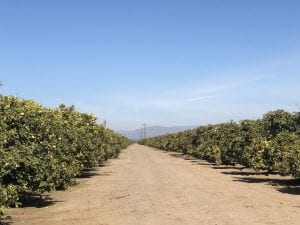For more than two centuries, citrus has grown strong in California’s backyards and groves – serving as a source of nourishment, income and tradition for many different individuals – but all of this is at risk due to Huanglongbing’s (HLB) growing presence in California.
HLB is a death sentence for California citrus, as the deadly plant disease has no cure and once a citrus tree is infected, it will die. Since the first tree was identified with HLB in California back in 2012, state officials from the Citrus Pest & Disease Prevention Division (CPDPD) have located and removed more than 2,300 diseased residential citrus trees throughout Southern California. As a result of CPDPD’s efforts in surveying, treatment and swift removal of the infected citrus trees, HLB has not yet been found in a commercial grove; however, California growers must continue to hold strong. The California citrus industry has spent a considerable amount of time and resources to suppress the Asian citrus psyllid (ACP) and to contain HLB, and the state shouldn’t slow its efforts anytime soon to push forward and preserve the $3.4 billion industry.
However, HLB is not exclusive to California and has forced several top citrus producing regions across the world to fight off the deadly disease. Florida is no stranger to this practice and has witnessed first-hand the devasting consequences this pest and disease can have on an industry. First appearing in Miami-Dade County in August 2005, HLB quickly made its presence known to Florida residents and citrus growers alike and remains the greatest threat the state’s citrus industry has ever faced. As a result, the cost of citrus production per acre has increased significantly during the past 15 years – primarily driven by the added costs of managing HLB.
Pete Spyke, a third-generation citrus grower in Florida, recently reached out to the Citrus Pest & Disease Prevention Committee (CPDPC) to encourage California citrus growers, industry members and homeowners to continue the positive progress the state has made over the past decade, noting California “still [has] an excellent opportunity to preserve your citrus industry … by doing what you’re already doing.”
As part of the industry’s comprehensive efforts, several regulatory measures have been set in motion across California to protect the state’s coveted crop, and range from ACP and HLB quarantine zones, residential treatments, tarping requirements, bulk citrus movement mitigation steps and more. In addition to these measures, a set of recommended voluntary best practices for growers – which are grouped based on a grower’s proximity to an HLB detection – were developed in 2019 and represent the most effective tools known to the citrus industry at this time. Endorsed by the CPDPC, these best practices were developed by a task force consisting of growers from various regions across the state and scientists, including some of the state’s most renowned scientists and researchers.
“California is on the right path as we continue to follow and encourage effective regulatory measures and voluntary best practices that can be implemented throughout the state in the effort to prevent the spread of ACP and HLB,” said CPDPC chairman Jim Gorden. “Pete and other Florida growers have shared their cautionary tales with us, and I firmly believe that if we follow on our path forward, while continuing to explore new solutions, California’s citrus industry will remain prosperous.”
“The positive choice for California is to continue to invest in detection, including finding new technology and maintaining required manpower on the ground,” said Spyke in his letter to the CPDPC. “Don’t waiver when removing infected trees immediately to protect the remaining backyard and commercial trees. Any cost is much less than that of losing much of your industry.” Florida’s signature orange crop is now less than one-third of what it was roughly 20 years ago because of this disease, but California growers still have time to avoid the same fate. While much has changed since the California citrus industry came together more than 10 years ago to support the creation of the Citrus Pest & Disease Prevention Program (CPDPP), one constant remains: the program’s dedication to fight HLB. It has never been more important for the California citrus industry – including the CPDPP, regulatory authorities, citrus growers, the scientific community and others – to work together to prevent the spread of the disease and save California’s citrus industry.

The Citrus Pest & Disease Prevention Program is an initiative funded by California citrus growers and administered by the California Department of Food and Agriculture dedicated to combating serious pests and diseases that threaten the state’s citrus trees. For more information, visit CitrusInsider.org.











